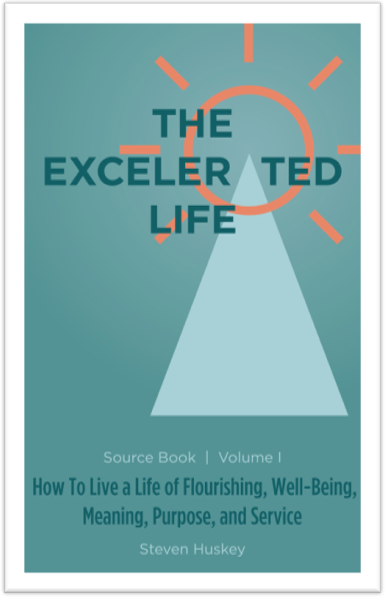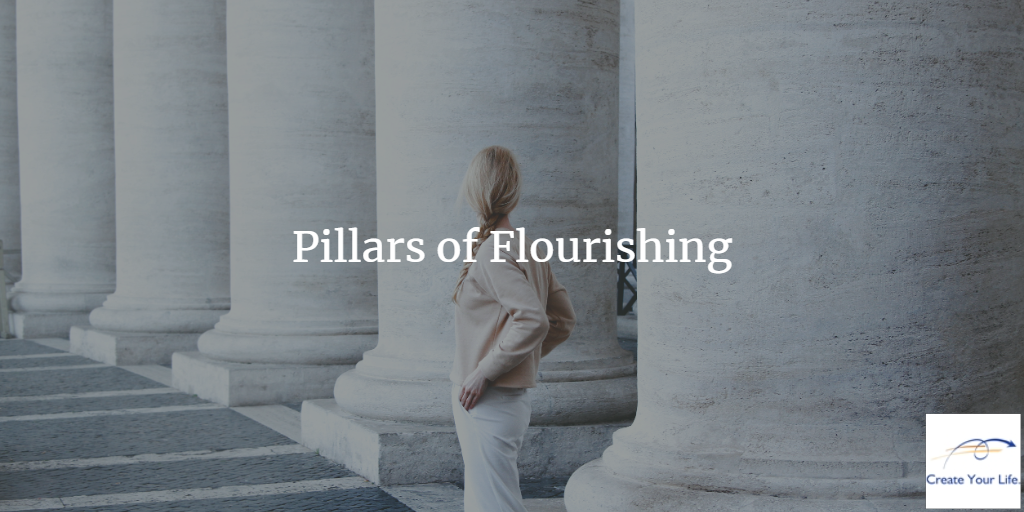You have the choice to flourish or flounder. By nourishing yourself in the five areas of human flourishing – happiness and life satisfaction, physical and mental health, meaning and purpose, character and virtue, and close social relationships – you are creating your own pillars of flourishing.
Flourishing or Languishing?
When we were in our late teens, my younger brother became interested in house plants. One of the first ones he brought home was a spider plant. It was such an interesting plant, I decided I wanted one, too. So I went out and bought one for myself.
Unfortunately, my early interest soon waned and I pretty quickly began to mostly ignore my little plant. I watered it, but only sporadically, when I thought about it. Some weeks, it got watered four or five days, some weeks, it got no water at all. The little plant sat on a corner of a table in my room, so it didn’t get much sunlight. And I’m afraid I never thought to feed or fertilize it.
My spider plant hung on out of sheer stubbornness but it did not flourish.
My brother’s spider plant, however, told a different story. He watered it on a regular basis, not too much and not too little. And he attached a hanger near his bedroom window where the plant could get sufficient sunlight. Then, he researched and found a good plant food for spider plants and fed his plant on a regular schedule.
His plant flourished with thick foliage and sent out lots of babies, shoots that hung in the air which could be plucked and planted as new plants.
Flourishing or languishing, our life’s story often boils down to the care we receive. The line between surviving and thriving is drawn by our choices. So let’s explore the pillars of flourishing.

What Does It Mean To Flourish?
When I think about flourishing, I remember how I first heard the word. It was in regard to plants. I think of a plant that is flourishing as one that has luxuriant foliage, with lots of flowers or fruit, healthy and thriving, just like my brother’s spider plant. When you and I are flourishing, we are thriving and vigorous, healthy and happy, doing good in and for our world.
Barbara Fredrickson, a Positive Psychology researcher, teacher, and author, said this about flourishing: “Positivity transforms us for the better. By opening our hearts and minds, positive emotions allow us to discover and build new skills, new ties, new knowledge, and new ways of being.” [Fredrickson] And so we flourish.
Five Areas of Human Flourishing
Research identifies five specific areas of human flourishing, areas to focus on as we look to improve our own levels of positivity. The five areas are: happiness and life satisfaction, physical and mental health, meaning and purpose, character and virtue, and close social relationships. These are the pillars of flourishing.
By focusing on these five areas we can reach a “positivity ratio” of 3:1 – three positive experiences for every one negative experience. From her research, Dr. Fredrickson suggests this 3:1 ratio as a prescription for flourishing. Let’s take a few minutes to look more closely at each one.
Happiness and Life Satisfaction
Happiness and life satisfaction refer to how much we find our lives to be meaningful, purposeful, and of a high quality.
Happiness is momentary but life satisfaction is a long-term feeling. It’s based on a feeling of overall well-being and comes from finding meaning and purpose in our lives [Badri]
Physical and Mental Health
The World Health Organization (WHO) defines physical and mental health as “a state of complete physical, mental and social well-being and not merely the absence of disease or infirmity.”
Physical health of course is our bodies’ ability to function normally. It is a part of total well-being and includes “how your body grows, feels and moves, how you care for it, and what you put into it.”
[“What is physical health?”]
Mental health is our ability to manage thoughts, emotions, and behaviors. Good mental health allows us to better handle stress, relate to other people, and make healthy choices.
Meaning and Purpose
Living a meaningful life includes having a sense of purpose and a direction for your life.
Purpose has two forms: universal and unique. We all share a universal purpose of Service, using our gifts, talents, strengths, and skills in service to the world. But the way each of us chooses to be of service is our unique purpose. This is based on our particular combination of gifts, talents, strengths, and skills.
The meaningful life also includes feeling connected to and serving something larger than yourself. [Seligman]
Character and Virtue
“All human beings seek to lead lives not just of pleasure, but of purpose, righteousness, and virtue.” ~ David Brooks
Cultivating a strong and virtuous character is an important part of flourishing. It means we have a strong sense of ethical and moral principles. It also includes working at being a good person and seeking to have a positive impact on our community and to make our world a better place.
Close Social Relationships
We humans are social animals. We need each other and we are built to seek companionship. A lack of social support negatively impacts our potential for happiness and well-being. Social connections increase our feelings of happiness, contentment, and well-being. And they not only make us happier but they improve our health and perhaps help us live longer. This is an essential component of flourishing.

Putting Ideas into Action
Here are some suggestions for building up your pillars of flourishing. Use them as presented or let them spark your creativity as you develop your own plans.
Happiness and Life Satisfaction Actions
The Happiness Hundred contains 100 exercises you can do right now to increase your feelings of happiness. Use The Happiness Hundred to find actions that can improve your happiness and life satisfaction. You can download your free copy here.
Physical and Mental Health Actions
Get enough (+ better) sleep. It’s said that a productive day begins the night before. This is especially true if we include getting a good night’s sleep. Find specific suggestions for getting better sleep here and here.
Develop a self-care plan. Schedule your self-care time and make it a priority. It doesn’t have to be a huge chunk of time, but plan something every day. If you want some ideas to get your thinking started, look in here.
Prioritize your physical health. In addition to getting adequate sleep, engage in regular activities that you enjoy. This might include walking, yoga, swimming, dancing, or practicing T’ai Chi Chih. Along with sleep and movement, focus on consuming a balanced diet with plenty of fruits, vegetables, whole grains, and lean proteins.
Practice mindfulness and relaxation techniques. Incorporate mindfulness practices into your daily life to reduce stress and promote emotional well-being. This can include deep breathing exercises, meditation, progressive muscle relaxation, or engaging in activities like yoga or T’ai Chi Chih.
Meaning and Purpose Actions
A first step toward finding meaning in life is to know your purpose. For help in discovering your purpose or in getting more clarity, try the “Find Your Purpose” worksheet. Of course, your unique purpose may change or become clearer over time. But know what it is for you right now.
- Now, think of your unique purpose and list three ways you can live into it.
- How will you know that you are living on purpose in each of those ways?
- What actions do you need to take to accomplish this?
- How and when will you take the first step?
Character and Virtue Actions
“Character isn’t something you’re born with and can’t change, like your fingerprints. It’s something you weren’t born with and must take responsibility for forming.” ~ Jim Rohn
Identify your core values. What is important to you? What do you believe in? Once you know your core values, you can start to align your actions and decisions with them. If you want some guidance in determining your core values, The Excelerator Jump Start – Valid Values is a tool you can use.
Find a role model. Massimo Pigliucci and Gregory Lopez call this the “sage on your shoulder”. [Pigliucci] Think of some people – living or dead, real or fictional – you admire for their character and virtue. Model their behavior and try to learn from them.
Set goals to help yourself become the kind of person you want to be. What virtues do you want to cultivate? What specific things can you do to grow those virtues?
Help others. Giving some of your time to help others helps you build character and develop virtues such as selflessness, empathy, and responsibility.
Use your character strengths to enhance your character and to help you be the best you. Paying attention to and using your strengths is the fastest way to become your best self. Focus on using your Signature Strengths to be the best you you can be. Don’t know yours yet? You can find them here.
Close Social Relationships Actions
Here are steps you can take to strengthen your relationship ties, adapted from Sonja Lyubomirsky’s The How Of Happiness.
Make time.
- Commit to spending one-on-one time with your partner each week.
- Each day, express appreciation or gratitude for specific behaviors.
- Before you part in the morning, find out one thing each of you is going to do that day. When you meet again, have a reunion conversation in a low-stress setting and listen.
- Schedule several hours once a week and make it a dedicated ritual. During this time, do something, or share an experience, together.
- Create a media-free zone in your home, reserved for conversations only.
Express admiration, appreciation, and affection.
- Happy relationships are characterized by a ratio of 5 positive statements or behaviors to each negative one. Resolve to raise your positive-to-negative affect ratio each week.
- Communicate your admiration and gratitude directly to your partner.
Use Active/Constructive responses to good news.
- The difference between good and poor relationships is not in how partners respond to each other’s disappointments and reversals, but in how they respond to good news. Resolve to respond with interest and enthusiasm to your friend’s and loved one’s good news. When your partner is excited to tell you something, pay close attention, ask lots of questions, and relive the experience. If you are happy for them, tell them so.
Manage conflict.
- Happy couples fight fair. Avoid criticism, contempt, and stonewalling.
- You can voice a complaint without making it a criticism of the other person’s character.
- Look for ways to deescalate tension and negativity during an argument, such as using friendly humor or expressing affection.
Share an inner life.
- Each week do at least one thing that supports your partner’s roles and dreams.[Lyubomirsky]
Strengthen Your Pillars of Flourishing
- Select one of the five areas to concentrate on. This may be an area where you are already strong or you might pick an area where you are not as adept. Devise one small thing you could do to improve or strengthen this pillar.
- Schedule a time when you will do this activity, either at a specific time or attach it to an activity you already do each day. For example, “when I brush my teeth”, “when I pour my coffee”, “when I do the dishes”, etc.
- Do it.
- Tomorrow, do it again.
- Continue until this part has become habitual.
- Select another area and repeat the exercise.
Remember the spider plants in my story? One flourished, one barely survived. The plants started out the same, but one received proper care, while the other was neglected. You, too, have the choice to flourish or flounder. By nourishing yourself in the five areas of human flourishing – happiness and life satisfaction, physical and mental health, meaning and purpose, character and virtue, and close social relationships – you are creating your own pillars of flourishing. And that’s one step in embracing your Excelerated Life™!
Are you flourishing and thriving, or just getting by?
How could you improve on one of your pillars today?
Share your ideas by leaving a post below.
Excelerated Positivity™ — building the skills that help you flourish — is one practice for creating your Excelerated Life™, a life of flourishing and well-being, and a life of meaning, purpose, and service.
Read more about the Excelerated Life™.
Resources:
Badri, Masood A., et al. “Exploring the Reciprocal Relationships between Happiness and Life Satisfaction of Working Adults” National Library of Medicine. National Library of Medicine, March 19, 2022. Web. September 2, 2023.
https://www.ncbi.nlm.nih.gov/pmc/articles/PMC8955857/#:~:text=Kahneman%20and%20Riis%20%5B46%5D%2C,on%20achieving%20life%2Dlong%20goals.
Brooks, David. The Road To Character. New York: Random House, LLC, 2015.
Fredrickson, Ph.D., Barbara, L. Positivity. New York: Crown Publishing Group, 2009.
Lyubomirsky, Sonja. The How Of Happiness. New York: Penguin Books, 2007.
Pigliucci, Massimo and Gregory Lopez. A Handbook For New Stoics: How To Thrive In A World Out Of Your Control. New York: The Experiment, LLC, 2019.
Seligman, Ph.D., Martin E. P. Flourish. New York: Free Press, 2011.
“What Is Physical Health?” Defence Force. A Force for New Zealand,. Web. September 2, 2023.
https://health.nzdf.mil.nz/your-health/body/physical-health-and-fitness/what-is-physical-health/#:~:text=Physical%20health%20can%20be%20defined%20as%20the,it%2C%20and%20what%20you%20put%20into%20it.


